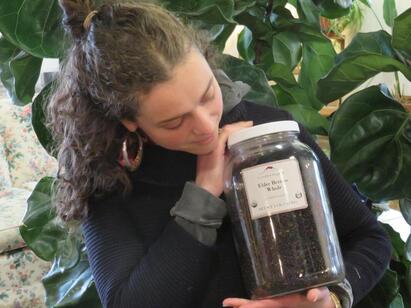 By Guido Masé RH (AHG) In the story of the battle of Marathon it's rumored that, after running back to Athens following his people's brutal battle with the Persians, Pheidippides uttered a single word - nike!, which means victory - before collapsing dead from exhaustion. He most likely meant to convey news of victory in battle, but he may have meant it for himself, too: despite his unfortunate end, there must have been a moment of deep joy and satisfaction once he actually made it home. So the outcome, I'm learning, may mean less than the struggle: experiencing challenge, whatever that means to you, is more life-giving than actually surviving, coming in first, or whatever external measure of success you may choose. When performed repeatedly, the process makes us "better", more creative, and more confident. Some say adversity builds character, but I'd say that it's moving through the adversity that really makes us strong. So for me, finding a way to experience the tough parts of life routinely, in a safe way, is an important spiritual practice. I use physical exertion to do this, and specifically running. I won't go in to why I think running is the best tool for this - that's really just my own opinion. Ultimately, it doesn't matter how you get there, be it through running, other physical activity, meditative practice, fasting, your job, or maybe just your life's circumstance (the fact that I have to actually work at finding adversity in life is a reflection of my societal privilege). So if you're a runner, what follow are some of my thoughts on training, progress, and balance. If you find your challenge elsewhere, take them as a metaphor. We don't train for speed or distance - those are just tools. We train to keep going through the tough bits.  Speed and distance are ways to get us there. How do you know that you're experiencing difficulty in training? Well, it just feels difficult! But beyond the subjective feeling, there is a semi-objective way of quantifying your level of physical exertion: the ratio of strides per breathing cycle. A breathing cycle is inbreath-outbreath. It's interesting to note that this cycle tends to settle into a regular rhythm with strides: during a light jog, you might get three strides in for each in-breath, and three more during the out-breath, for a total of six strides per cycle. Five strides per cycle is still pretty relaxed, but by the time you're at four strides per cycle, you are certainly working a little harder. I aim for this target in my workouts: the first quarter should be at four strides per cycle, the second and third quarter at three strides per cycle, and by the time you're at the last quarter, you should be experiencing some two-strides-per-cycle stints fairly frequently. Two strides per cycle is tough. It's hard to sustain. Try to sustain it. Since the level of oxygenation required is a direct reflection of your fitness, there's no "pace" that correlates to two strides per cycle. It depends how fast you're going, how far you've gone, and how fit you are. You can get there quick with speed. You can get there slow with distance. But I've often thought, breathing in-out-in-out with every step, how the feeling I'm experiencing is the same feeling all humans have had at this level of exertion. It's universally relate-able. We may be going at different paces, but it's tough - and if we can push through it, we feel amazing! It's an altered state few even get to touch, let alone indulge.  Speed is the tool of fire - it's short, but intense. There are a couple of ways to experience difficulty using speed: you can go at a tough pace for a medium distance, or you can go really fast for a short stint, take a little break, and repeat (a practice known as "intervals"). As usual, start with a pace that puts you into four strides per cycle. If you're not moving naturally into a three-strides ventilation cycle by the 1/4 mark, you need to speed up. See how this can work for any distance? If you want to go for two miles, you should be switching to three strides by the half-mile mark. If you want to go for twenty miles, hold off until you reach the five mile mark. Interestingly, when using speed as a tool, your heart rate is generally higher. Herbs that support this training are often hot and fiery themselves: ginger, cayenne, even turmeric. They improve circulation and maximize oxygenation. The injuries that result from fire-training are injuries to the soft, connective tissue of the body: ligaments and tendons. Herbs that support these are cooling and often demulcent: solomon's seal, comfrey, horse chestnut. Too much yang injures the yin. Distance is the tool of water. It's long and slow, but grinding - eroding at you like waves on a rocky coast. You get to the tough parts by exhausting all your energy - a different feeling from the muscular fatigue that accompanies speed, but an important one to dance with. What's "distance"? It varies from person to person. If you start getting into a two-strides-per-cycle pattern after two miles, even if you start out nice and easy, then two miles is "distance" for you. But regardless, if you aren't into a three-strides pattern by the halfway mark, you need to pick up the pace.  When using distance as a tool, you need to feed your system with watery, nourishing herbs and foods: oats, even licorice. And the injuries that come from distance are often injuries to the vital fire: we need adaptogens like rhodiola, schisandra, eleuthero and cordyceps if we find that distance workouts leave us feeling achy, depleted, and listless the next day. Too much yin injures the yang. Speed and distance are the fire and water, the light and dark, of training. Try for a little of both each week. But both are challenging. Though they reflect balance, we also need to balance difficult training with more restful, "easy" days. If you run three days a week, try for one speed day, one distance day, and one day where you stay at four strides per cycle or more for the whole run. This gives you a chance to warm up your body and then maybe do some gentle stretching or strength training afterwards. If you feel tired, haven't gotten enough sleep, or are a bit under the weather, consider modifying your workout: if you're going for speed, keep the same pace but go a shorter distance. If you're going for distance, keep the same mileage but go slower. Eat well. Take your herbs. Sleep deeply. Finally, there's a seasonal cycle as well. Find the time of year when you like to go faster and farther. Find the time of year to focus on less vigorous exercise, too. If you listen to your body while ensuring regular, ongoing discomfort, then you will embody the spirit of the equinox: balanced, but rushing. Perfectly poised, but wildly flying apart. The repeated experience of challenge will make you stronger, and your mind and emotions will benefit, too. Victory! Guido Masé is a clinical herbalist at the Burlington Herb Clinic. Learn more about Guido's work as an herbalist here. He and other herbalists at the clinic are available for consultations. By working with an herbalist, you'll receive personal guidance through the process of using herbs and nutrition to better your health. Book an appointment here, or contact us at [email protected], (802) 540-0595. Guido's personal blog can be found here.
3 Comments
How to make elderberry syrup for immune support:
Elderberry Syrup ingredients: - 1/2 cup dried elderberries or 1 cup fresh (or frozen) elderberries (Sambucus nigra)⠀ - 2 cups water⠀ - 2/3 to 1 cup honey⠀ ⠀ Optional additions:⠀ - 1 tsp dried ginger (or 2 tsp. fresh or frozen ginger)⠀ - 1-2 tsp cinnamon chips⠀ - 1-2 tsp astragalus root⠀ - 2 tsp rose hips⠀ ⠀ Combine elderberries and water and simmer until water is reduced by half. Mash the herbs in the water and then strain out. Take remaining water and add ⅔ to 1 cup of local raw honey to taste. Store in refrigerator for up to 6 months.⠀ ⠀ Some people take the syrup as a daily tonic during cold and flu season, 1 tablespoon for adults or 1 teaspoon for children over age one. If you are feeling sick try 1 tablespoon every 3-4 hours up to 6 times in 24 hours (for children over one use 1 teaspoon).⠀ ⠀ Elder is an incredible and powerful plant that we have a lot of respect and gratitude for - it has helped keep generations of people healthy in many parts of the world. When using this plant we invite you to do so with an attitude of appreciation and respect for what is truly our elder.⠀🌳 💚 P.S. Frozen elderberries are available seasonally here at Railyard, you can order for in-store pickup here or order dried elderberries for pick-up or shipping here. Fire Cider has become one of the most quintessential herbal preparations of our time. It captures both the imagination of people new to working with herbs to support their health, while remaining a staple preparation for those seasoned in the use of herbs. Who knows how long people have been creating this kind of warming and supportive vinegar... but it surely is a folk medicine of the people. Recently there was a company that tried to trademark the phrase 'Fire Cider'. Members of the herbal community brought this company to court, and after years of effort the courts ruled in the favor of the herbalists dedicated to keep this medicine, and its name, in the hands of the people. A big victory, indeed. These recent events reveal Fire Cider as an exciting remedy that links us to the past, while being rooted in modern health freedom and the resistance of corporate control. And when you make your next batch, you may want to share this story as you share a shot of this invigorating preparation. Fire Cider is accessible and effective. It threads the line between herbal medicine and food as medicine. The method of preparation is simple, flexible, and intuitive. And to top it all off, each and every ingredients is commonly available in most every grocery store. Early autumn is the perfect time of year to make yourself a jar, as this warming remedy is a fantastic accompaniment to the colder weather rolling in. If you make a batch soon, you will have some on hand for that first sign of cold or flu. Fire Cider supports and stimulates our immune systems and can be helpful in moving stuck mucus in the respiratory tract. For those of us who run on the cool side (ie. cold hands and feet), Fire Cider can be had on the daily as a warming circulation tonic. Fire Cider also supports digestion, behaves as a general respiratory support, and is anti-inflammatory. Fire Cider can be had by the spoonful, shot straight, or mixed with a little water. It is a nice addition to salad dressings, soups, or to top all kinds of food, a bit like a hot sauce. As a daily tonic 1 teaspoon-1 Tablespoon/ day is sufficient. For acute immune support, consider having 1-2 tablespoons to start and then an additional tablespoon every 3-4 hours. For those of us with stomachs that are very sensitive to spicy food, consider experimenting with how much feels good. The honey mellows some of the spicy components, and is in itself medicinal. Add honey to taste after straining. There is no one recipe for Fire Cider, which is part of its charm. Below you will find basic guidelines for amounts. Fire Ciders almost always contain: ginger, onion, garlic, hot peppers, and horseradish infused in apple cider vinegar and honey (preferably raw). But let your imagination run wild and add herbs or other ingredients to suit your specific needs and tastes. Some of our favorites are: fresh herbs like sage/thyme/ rosemary, organic lemon (rind and pith), echinacea root, rose hips, medicinal mushrooms, and hibiscus. Ingredients (estimated amounts): 1 medium sized onion, chopped small 1-2 heads of garlic, minced ~1/2c ginger, chopped small ~1/2c horseradish, chopped small 1-2 hot peppers (Ideally fresh jalepeños or cayenne. Can also use dried), minced 1 lemon, chopped small (use the skin and pith if organic) 1 quart+ apple cider vinegar (enough to cover herbs in the jar well) Use raw if possible. ~1/2-3/4c honey (added after straining, to taste) Use raw if possible. Materials: 1 large quart sized (or larger jar) Knife Cutting board Small piece of parchment or wax paper Let sit for 2 weeks or more, shaking every other day or so. Strain and add honey to taste. Enjoy and cheers to a cozy and safe winter season! Thanks for reading! Let us know if you have any questions! Also FYI, you can check out our video about making "DIY Oxymels" to learn more about how to use herbs, vinegar and also honey to make a variety of delicious herbal preps. Download here. Susan Staley is a clinical and community herbalist staff member with Railyard Apothecary. She deeply values those herbs and plants commonly available to us today in most grocery stores, and the where the edge blurs between food and medicine. You can schedule a conversation with her or other members of Burlington Herb clinic here: https://www.burlingtonherbclinic.com/
 This time of year during the seasonal transition is a good time to think about our health in general, and this year especially to think about immune health. Our bodies become challenged during the change from one season to the next: where once it was easy to stay warm, for many it now requires an adjustment. Where once we were swimming in the warm humidity of summertime air, our bodies now grow accustomed to a cold, drying wind. We make all sorts of changes - our clothing, our outdoor habits. How can else can we ready our bodies for this time of year? Please make sure to check out Sue's blog about "late summer" for some general tips regarding food and herbs. It's important that herbs not become a substitute for a healthy diet and lifestyle - they simply can't make up for a lack of those things. In this article I'll be focusing in more detail on two of our most esteemed immune supportive herbs for when you're already doing all you can to stay healthy but are looking for a little extra support. These herbs can be especially helpful for those with compromised immune systems (though care needs to be taken). Astragalus Scientific name: Astragalus membranaceus (Fabaceae) This pea family plant is one of our most important "immune tonic" herbs. The root of this plant is used, either as a powder, tincture or decoction. It's native to China, where the root is cooked in soups for immune health. It's "food-like" nature makes it a generally well-tolerated and safe herb, one that must be taken in sufficiently large quantities to have the desired effect. (It's still important to do your research and talk to your doctor before taking herbs - this particular herb has an effect on immune cells, a possible issue for people with some medications or conditions.) The way this plant works is to gently stimulate the immune system, elevating white blood cells and other immune cells. In Traditional Chinese Medicine, it is said to be supportive for people with deficient "Wei Qi" or the "protective Qi" that we associate with immunity in the West. In our clinical practice we often recommend this plant to people with compromised immune systems, such as those undergoing treatment for cancer. For anyone, it's gentle support helps keep the immune system strong. It's best to avoid if you are actively sick. How to take:
 Jessica with a beautiful reishi mushroom! Jessica with a beautiful reishi mushroom! Reishi mushroom Scientific name: Ganoderma lucidum (from China), Ganoderma tsugae (local species) Seek medical advice before use of this mushroom - people with mold allergies may have adverse reactions, it may dry out the mucous membranes in sensitive individuals, it may impact the liver, and may interact with certain medications or medical conditions. Reishi mushroom is another one of our most important "immune tonic" herbs (we call it an herb though it is indeed a mushroom!). The fruiting body of this mushroom is tough and woody, so slices of it are used to make soups and teas, or it is extracted, dried and powdered. Sometimes known as the "mushroom of immortality" it is another one with extensive use in China, and the local tsugae species that grows here in Vermont is used in the same way. Similar to astragalus, for immune supportive purposes reishi mushroom is taken daily to gently modulate and stimulate immune function. The polysaccharides in the mushroom pass through our GI lining appearing potentially like something our immune system needs to deal with, keeping the immune system on a higher level of alert. Because of it's modulating effect, it may also help with an over-active immune system, making it an herb that many people take throughout the allergy season. It has a number of other ways it may support the body, including supporting the heart, lungs and liver. For now we'll just leave it as another one can help keep us healthy during this time of year, especially those who may have deficient immune function. Avoid if actively sick. How to take:
Conclusion We're very grateful to have this wonderful plant and mushroom in our lives, to support us and our community when a little extra immune boost is needed, and we humbly give our gratitude to the wonders of natural medicine. We again encourage readers to consider all the ways to keep your body, mind and spirit strong and healthy through appropriate diet and lifestyle practices (see Sue's article for some tips), and to not over-rely on these special and wonderful herbs. They are there when we need them, and we hope to maintain this special relationship with the healing powers of the natural world for generations to come. By Nick Cavanaugh. Nick is a clinical herbalist at the Burlington Herb Clinic. You can book an appointment with Nick for an herbal consultation here.  This late summer, more than others in recent memory, we may be more keenly aware of the way the light is changing. It moves across the landscape with the laziness of summer and the early haste of the colder seasons. But it isn't just the warm, low, honey-toned rays saying that autumn has begun to twirl their song in our direction. It is the first chilly nights in a while. It is the leaves along the tippy tops of the trees trading in green for gold. It is the increasing taste for apples and the first thrills of being cozy. Ah, late summer you beautiful creature of a world, where we occupy two seasons truly at one time. Thankfully there is a late summer to ready us for autumn, and an autumn to ready us for Winter in the northeast. We have some time to ease in and make small adjustments to our routines. We have some time to ease into the wee shifts that help our bodies feel safe and our needs met in the changing environment. Thus we follow the age old tune, "so within, so without". As the temperature cools, our bodies cool. As the energy of the plants moves slowly from fruits to roots, we too shift increasingly inward in various ways. Transition, no matter how well anticipated (or not), will always present both challenge and opportunity. In a truly ever changing world, the ways by which we engage and adapt to a moment, a day, a season, and a life stage will make a difference one way or another. The transition from late summer to winter, even though it may seem premature, is a particularly good time to begin leaning into the support and fortification of our immune systems. The earthy cores of our body are still warmed by the summer sun, and if we care for this warmth now we will be better suited to meet the challenges that the colder days bring. When it comes to herbs and food, consider drinking teas in the evening with aromatic warming spices like tulsi, cinnamon, fennel, ginger, and chamomile. Sip warm water throughout the day. Start incorporating soups and braised dishes with beans and seaweed into your weekly meal planning. If you don't already have a stock back in your freezer now is as good a time as any to start one, and broths can be enriched with deeply immune supportive herbs like astragalus root*, medicinal mushrooms, mineral-rich herbs, bones, and various seaweeds. And a world on "dryness". Autumn is a notoriously dry season (think of the leaves!), which can cause the tissues of our upper and lower respiratory system to need some extra moisture. Moistening herbs pair well with aromatic herbs this time of year. Consider marshmallow root, burdock root, licorice root, linden blossoms, and violet leaves. Wishing you, dear reader, the insight to identify the small simple ways you can make room in your day to look after your future self, and the inspiration to follow through. *Astragalus root is our September Herb of the Month! You can find high-quality, organic bulk root and powdered root for 50% off and bulk organic tincture and glycerine for 25% though the month! Click here to order. There will also be a FREE class on this amazing plant Wednesday September 9th, 6-7pm. Pre-registration required, register here. By Susan Staley Susan is a clinical and community herbalist. Her current practice is with The Clinic at Railyard. You can schedule a conversation or consultation with her, or any of our herbalists, here. |
Details
RAILYARDCheck in here to keep updated on news and activities at the apothecary. Archives
April 2024
Categories
All
|
railyard apothecary
*These statements have not been evaluated by the Food and Drug Administration. This product is not intended to diagnose, treat, cure, or prevent any disease. For educational purposes only.
|
|







 RSS Feed
RSS Feed
